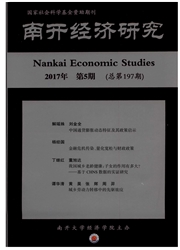

 中文摘要:
中文摘要:
利用2004--2010年我国行业层面的面板数据,分别运用工具变量两阶段最小二乘法和系统广义矩估计方法,本文计量分析了生产率是否是我国企业“走出去”的决定因素。结果表明:与异质性贸易理论关于生产率是企业开展对外直接投资决定因素的结论不同,生产率并非是中国企业“走出去”的决定因素,我们将这一现象称之为中国企业“走出去”的生产率悖论;但出口规模和以出口外向度比较优势为表现的行业外向型发展程度,对企业“走出去”具有显著正面影响,因此,本文认为中国企业“走出去”的生产率悖论,实质上源自于现有文献所揭示的出口企业的生产率悖论。本文研究还发现行业规模优势、政府参与以及政策支持均对企业“走出去”具有显著促进作用。据此,在国内产业尚不具备结构高级化先决条件和优势条件下,加快推动中国企业“走出去”,应通过充分发挥中国在位出口优势和某些出口行业的规模优势,以及加大政府支持力度,以克服包括企业生产率等方面的“所有权”劣势。
 英文摘要:
英文摘要:
By using industry level data covering from 1994 to 2010, and by adopting TSLS and System GMM estimation method, we carry out econometrical analysis on the role of productivity in Chinese firms' going globally. Results indicate, contrary to the prediction of heterogeneous firm trade theory that productivity is key factor in determining firms direct investment, productivity is not the determinants of Chinese firms' going globally. This phe- nomenon can be called Chinese firms' productivity paradox in going globally. At the same time, export volume and RCA have positive impact on Chinese firms' going globally. Therefore, this paper argues that productivity paradox in Chinese firms' going globally ac- tually results from export Chinese export firms' 'productivity paradox discover by current literature. Our results also indicate that industry scale advantage, state participation and policy support all have positive impact on Chinese finns' going globally. Accordingly, under the background that domestic industry has not ownership specific advantages, in order to speed up Chinese firms' going globally, we should bring export volume advantage, export industry scale advantage and policy support into full play to offset firms' productivity disadvantage in going globally.
 同期刊论文项目
同期刊论文项目
 同项目期刊论文
同项目期刊论文
 期刊信息
期刊信息
